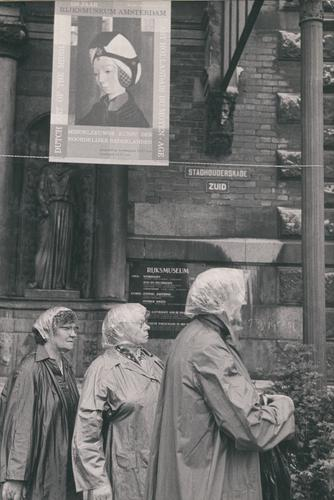
![]()
![]() Credits: M012254, foto, Leonard Freed, 1958 / Joods Historisch Museum
Credits: M012254, foto, Leonard Freed, 1958 / Joods Historisch Museum
by Vanessa Tünsmeyer and Marina Markellou
Introduction
The advancement of digitalisation has been both a challenge and an opportunity for the realisation of cultural rights, especially at the intersection of copyright law and cultural rights. The last two decades have witnessed a truly revolutionary shift in the ways cultural heritage material can be accessed and used by everyone, across the globe. The times where museum visitors had to wait in line in front of a museum to access its collections, as depicted on the photograph, are passed. One widely known example are digitised museum collections, a common practice for museums, including in Europe. Digital images of museum objects are used for educational purposes, or even transformed into wallpaper or phone cases. The dynamic movement towards openness in access and reuse of digital cultural heritage demonstrates that there is great momentum in the field, aiming at a wider dissemination of knowledge and creative reuse by communities and people. Examples can be seen in the practices of major institutions such as the Metropolitan Museum of Art in New York, but also in Europe with the recent platform of the French Ministry of Culture and the pioneering digital collection by the Dutch Rijksmuseum, called the Rijksstudio.
Copyright obstacles to digitising cultural heritage
These digital collections are interesting case studies, as they show the way in which copyright and cultural rights interact with each other. National copyright legislation has been an obstacle in the creation of digital museum collections, limiting the ways in which cultural heritage can be digitized by cultural institutions and the conditions under which images may be reused. Originally copyright was designed to protect the author’s moral and economic interests. But today, interpreting the application of laws across-borders, identifying the copyright status of collection items and dealing with (that is copyright-protected works, the rights owner of which cannot be identified or located by anyone who wants to make use of these works), are considered as some of the major challenges faced by institutions in relation to copyright in the cultural heritage sector. In the views of the authors, this has put museums in a difficult position where, on the one hand, they fulfil a crucial role within society - often with an explicit (government) mandate of protecting and sharing culture - while on the other hand being prevented from doing so to the fullest extent because of inconsistencies in copyright legislation. These obstacles negatively impact the realisation of cultural rights as they limit what cultural heritage is available digitally.
The role of digital collections for the enjoyment of cultural rights
A wider availability of digital imagery and archival information positively impacts the realisation of cultural rights in important ways. This includes both the rights of citizens who seek to enjoy culture and the rights of the person who “produce” tangible or intangible expressions of culture. Rights at issue are, amongst others, Art.27 of the Universal Declaration of Human Rights (hereafter UDHR) and Art.15 of the International Covenant on Economic, Social and Cultural Rights (ICESCR). Both articles protect a number of different cultural rights, including the right to enjoy the arts and the right to participate in cultural life, benefit from scientific progress and the human right to protection of authorship. To enjoy the arts (Art.27 UDHR) and participate in the cultural life (Art.15(1)(a) ICESCR), citizens need access to heritage. State Parties to ICESCR (including European countries) have undertaken obligations under international law to make cultural heritage accessible to individuals within their territory, as highlighted by the UN Special Rapporteur in the field of cultural rights. One way to improve “access” to heritage (Art.15(1)(a) ICESCR) is digitise it. For example, images of items that are kept in storage may still be placed online. But advancing digitisation also has the added benefit of improving access to heritage globally. Given the concentration of vast amounts of cultural heritage collections in relatively few institutions, the facilitation of digital collections, if it also includes source and archival data can be important not only for individuals in different parts of the world but also be of scientific benefit. The human right to protection of authorship, by contrast, includes the protection of the moral and material interests of the author, but these are understood differently than in copyright law. One big difference is the fact that human rights are non-transferable and cannot be held by corporations. In addition to recognizing the interests of the author / artist / museum visitor (or for example a website visitor of the Rijksstudio), Article 27 of the UDHR and Article 15 of the ICESCR conceptualise these different cultural rights within a wider net of inter-connected human rights of individuals. This includes other rights not touched upon by this article, such as the rights of minorities or Indigenous Peoples to their cultural heritage.
Efforts on the EU level to facilitate digitisation of cultural heritage
Recent efforts on the EU level represent one step towards removing the barriers that hinder digital access to cultural heritage. This in turn can improve the realisation of cultural rights. In recognition of the digital evolution, the European Commission has manifested its strong willingness to support the cultural heritage sector to make best use of their digital assets, in order to procure the full benefits of the digital transition, with three Recommendations that have been drawn up to date (2006, 2011, 2021). This includes urging member States to make more systematic use of the existing EU framework. Realising the importance of improving the European digital heritage space, specific measures have been taken at the EU level to address existing challenges for museums that arise out of copyright law. Directive (EU) 2019/790 on copyright and related rights in the digital single market (DSM Directive) lays down various provisions modernising the copyright framework that governs how cultural heritage institutions operate in the digital environment. One of the most important changes introduced by the Directive is a clear framework for the and dissemination of out-of-commerce works that cultural heritage institutions have in their collections. Moreover, the Directive introduces harmonised and mandatory copyright exceptions, which offer certain circumstances under which museums and other cultural institutions may use works from their collections without obtaining the consent of the copyright holder. These main exceptions refer to the making of preservation copies by cultural heritage institutions and concern text and data mining for scientific research. Finally, the Directive attempts to clarify the status of works of visual art in the public domain with the objective to increase legal certainty. In particular, the new copyright rules will facilitate a core public interest mission of cultural heritage institutions by enhancing the preservation and availability of cultural heritage and by significantly facilitating the use of works that are no longer commercially available, for the benefit of digitising European culture and of all citizens. Member States must therefore ensure an effective implementation and application of EU copyright legislation so that cultural heritage institutions can fully benefit from the copyright framework, as updated in particular by Directive (EU) 2019/790.
The interactions of copyright law and cultural rights
Copyright and its related rights in the European digital single market thus navigate the space between a multitude of interests, two of which were raised in this contribution: protecting the material interest of the author and improving access to cultural heritage so as to advance the access dimension of Art.15(1)(a)ICESCR. From a human rights perspective, the need to better align copyright law with the obligations states have incurred under human rights law has been visible for some time now. This becomes only more urgent the faster technologies develop. Implementing the DSM Directive and thereby reducing barriers to digitisation of cultural heritage would be one step towards improving the access dimension of the right to take part in cultural life, definitely within the EU but hopefully abroad as well. This would prove an important counterbalance to the focus of copyright on moral and material benefits of the author and would better align with the corresponding human rights, given that the human right to authorship is part of a wider web of rights and obligations. However, more alignment between these legal areas is needed, the discussion of which would go beyond this article. For example, the human right to authorship is not congruent with current copyright legislation, as seen, for instance, in the fact that in copyright law there are corporate right holders. In the words of former Special Rapporteur in the field of cultural rights Farida Shaheed “Protection of authorship as a human right requires in some ways more and in other ways less than what is currently found in the copyright laws of most countries”.
The authors agree with Caterina Sganga, that one possible step for further alignment of the two fields could be achieved through human rights impact assessments of the implemented Copyright frameworks on the national level. These could help to systematically monitor progress on the enabling environment for cultural rights in accordance with human rights norms and the social function of intellectual property. Taken together, these measures of decreasing barriers to digitisation and monitoring the impact of EU copyright law on human rights will show governments which other steps may be necessary in further adjusting copyright legislation and aid cultural institutions on the national level to share their collections in a way that best advances human rights.
Bios

Vanessa Tünsmeyer specializes in the area of cultural rights, minority and indigenous rights and cultural heritage law. In 2022 she published a monograph with Springer on aligning legal mechanisms on the return of colonial-era heritage with state obligations under human rights law. She has worked at universities in Germany and The Netherlands and was a visiting researcher at the Peter Allard Hall Law School in Vancouver, Canada. Currently she works as Assistant Professor at the Department of Legal Methods of the Rijksuniversiteit Groningen and acts as academic co-lead for an interdisciplinary research group on ‘Conflict, Environment & Justice'.

Marina Markellou is an Assistant Professor in Law at the Transboundary Legal Studies Department of the Rijksuniversiteit Groningen and an Intellectual Property Law Attorney, admitted to practice in 2003. After accomplishing a Master of Laws in Intellectual Property (LLM) on September 2005 in Montpellier of France, she was offered a scholarship by the Greek State to pursue a Ph.D. degree in the field of Copyright Law (University of Montpellier/University of Athens-high distinction). She specialises in Copyright Law, Cultural Heritage Law and everything at the intersection of Art, Law and Technology.